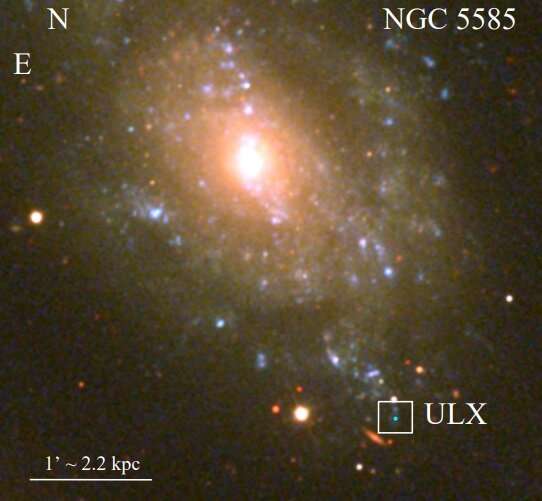December 15, 2020 report
Large ionized bubble around NGC 5585 X-1 investigated in detail

An international team of astronomers have conducted a detailed study of a large ionized bubble an ultraluminous X-ray source (ULX) in the galaxy NGC 5585. Results of the research, presented in a paper published December 7 on arXiv.org, provide more insights into the nature of this bubble.
ULXs are point sources in the sky that are so bright in X-rays that each emits more radiation than 1 million suns emit at all wavelengths. They are less luminous than active galactic nuclei, but more consistently luminous than any known stellar process. Although numerous studies of ULXs have been conducted, the basic nature of these sources remains unsolved.
Observations show that some ULXs are surrounded by collisionally ionized bubbles. Such features are assumed to be evidence of powerful outflows associated with super-Eddington X-ray sources. Identifying and studying these bubbles could help us better understand accretion processes in ULXs and also other astrophysical phenomena, such as phases of enhanced nuclear activity in normal galaxies, feedback processes in quasars, or the role of X-ray binaries and microquasars in cosmic reionization.
So a team of astronomers led by Roberto Soria of the University of the Chinese Academy of Sciences in Beijing, China, is conducting a long-term program of search, identification and modeling of ULX bubbles in nearby galaxies. As part of this program, they have studied a shock-ionized bubble in the outskirts of the galaxy NGC 5585 (located some 26 million light years away) using various space telescopes and ground-based observatories.
"Here, we investigate the large bubble around NGC 5585 X-1 in more detail. We collected and studied new and archival data in several bands: in the X-ray band with Chandra and XMM-Newton; in the optical band with the Hubble Space Telescope (HST) for imaging and the Large Binocular Telescope (LBT) for spectroscopy; in the radio band with the Karl G. Jansky Very Large Array (VLA)," the researchers wrote in the paper.
The bubble is huge when compared to similar structures in other galaxies. It has dimensions of about 1,140 by 717 light years and appears to contain a smaller H II (ionized hydrogen) region, apparently located at its northern end.
The ULX bubble was found to be completely dominated by collisional ionization, with no evidence of X-ray photo-ionization. The astronomers discovered a very strong radio emission from the bubble with resolved internal structure.
According to the paper, an average shock velocity for the bubble around NGC 5585 X-1 is at a level of 125 km/s. This value suggests a dynamical age of the bubble to be about 600,000 years and indicates that the long-term-average mechanical power that is inflating the bubble is approximately 20 duodecillion erg/s.
Summing up the results, the scientists noted how important are their new findings in the ongoing research program focused on the detection and investigation of ULX bubbles. "In conclusion, with this study, we have added another interesting specimen to the class of shock-ionized nebulae around supercritical accreting X-ray binaries. It is now almost two decades since their nature and importance as a diagnostic of mechanical output power were first recognized. Over this time, we have discovered several new cases, and we have made quantitative progress in their interpretation, refining the derivation of their age and kinetic power from their optical/infrared images and spectra," the authors of the paper explained.
More information: The ultraluminous X-ray source bubble in NGC 5585, arXiv:2012.03970 [astro-ph.HE] arxiv.org/abs/2012.03970
© 2020 Science X Network





















